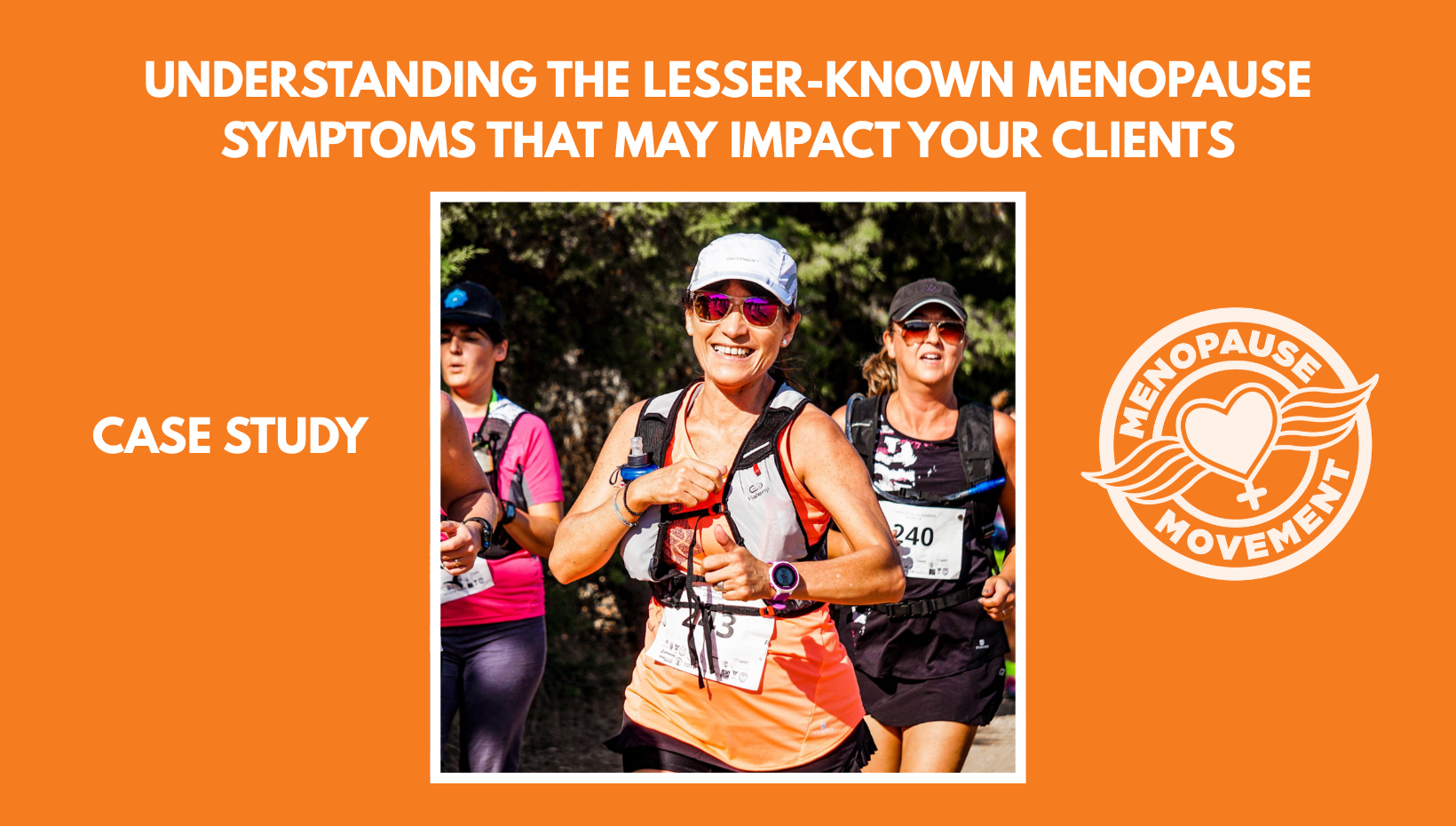
Understanding the Hidden Impact of Menopause in Physiotherapy Practice.
Meet Heather, age 52. Her last menstrual period was just over a year ago, meaning she is now post-menopausal. Heather is fit, active, and runs over 25km every week. She’s the kind of client many of us would describe as “doing all the right things.”
Yet, over the last couple of years, Heather has experienced changes she didn’t expect — recurring pelvic discomfort, increased bladder urgency, and a surprising diagnosis of osteoporosis. These symptoms, while not as commonly discussed as hot flushes or sleep disturbance, are part of the wide spectrum of menopause-related changes that can significantly affect physical function, exercise tolerance, and tissue health.
This case study explores the impact of low bone density and Genito-Urinary Syndrome of the Menopause (GSM) — two under-recognised consequences of menopause — and how MSK and sports physiotherapists can identify, assess, and support women like Heather in clinical practice.
Over recent years, awareness of menopause has grown considerably, and more women are seeking help to manage their symptoms, often through Hormone Replacement Therapy (HRT). However, many of the longer-term physiological changes — including bone density loss and GSM — may not appear until years after the menopause transition.
Women who do not experience the “typical” symptoms may assume they have escaped unscathed, but the reality is that menopause impacts every woman. As physiotherapists, it’s essential we use every clinical encounter to recognise and discuss these changes, ensuring women receive the education and support they need to remain strong, active, and confident.
Heather works in a sedentary role, spending long hours in meetings and on screens. She’s noticed that sitting for prolonged periods causes pelvic pain, itchiness, and dermatitis in the perineal area.
She also describes:
A few years ago, Heather experienced low mood, fatigue, and brain fog. HRT has helped stabilise these symptoms, but she was shocked when a DEXA scan revealed osteoporosis, despite her active lifestyle.
Heather’s main goals are to:
The menopause is not simply a hormonal change — it’s a neuro-endocrine transition that affects multiple systems, including the musculoskeletal, urogenital, cardiovascular, and nervous systems.
As physiotherapists, we’re uniquely placed to recognise these patterns early, screen effectively, and refer or signpost when appropriate. Understanding menopause-related changes enables us to offer holistic, safe, and evidence-informed care.
Research suggests that up to 90% of post-menopausal women experience some degree of Genito-Urinary Syndrome of the Menopause (GSM), which can include:
GSM is both underdiagnosed and undertreated, yet highly responsive to intervention.
Clinical recommendations:
Oestrogen is a major regulator of bone formation and resorption. During the menopause transition, bone loss accelerates—beginning about one year before the final menstrual period and continuing for around three years. On average, women lose 6% of their bone mass, but in some, the loss can be up to 15%.
DEXA scanning should be considered not only for women over 65 but also for younger post-menopausal women with risk factors such as:
Key message:
Supervised impact and resistance training are recommended interventions for post-menopausal women with low bone density — they are not contraindicated.
Practical guidance:
On average, women in the UK spend 20 years of later life in poor health. Declines in strength and power are key contributors to frailty and reduced independence.
During menopause, decreases in oestrogen contribute to the loss of lean muscle mass and neuromuscular performance, particularly in the quadriceps and gluteal muscles.
Clinical implications:
Heather’s case reflects the lived experience of many women navigating midlife and post-menopause. Recognising that issues such as low bone density and GSM are menopause-related empowers women to take proactive steps towards recovery and prevention.
As physiotherapists, we have an invaluable opportunity to:
By embedding menopause awareness into everyday physiotherapy practice, we can help women maintain independence, confidence, and wellbeing throughout later life.
The Menopause Movement Foundation and Advanced Practitioner Courses provide physiotherapists with comprehensive, evidence-based education on menopause and its systemic impacts. The multidisciplinary team includes:
We are also launching our Menopause MOT Clinical Package in the new year — designed to help physiotherapists deliver structured, holistic assessments and interventions for women in midlife and beyond.
🔗 Learn more at: https://www.menopausemovement.co/course#about
Every contact counts.
By integrating menopause-informed care into physiotherapy practice, we can make a profound difference to women’s long-term musculoskeletal and overall health.
Written by Christien Bird, Specialist Women’s Pelvic Health Physiotherapist and Clinical Lead at Menopause Movement.
October 2025